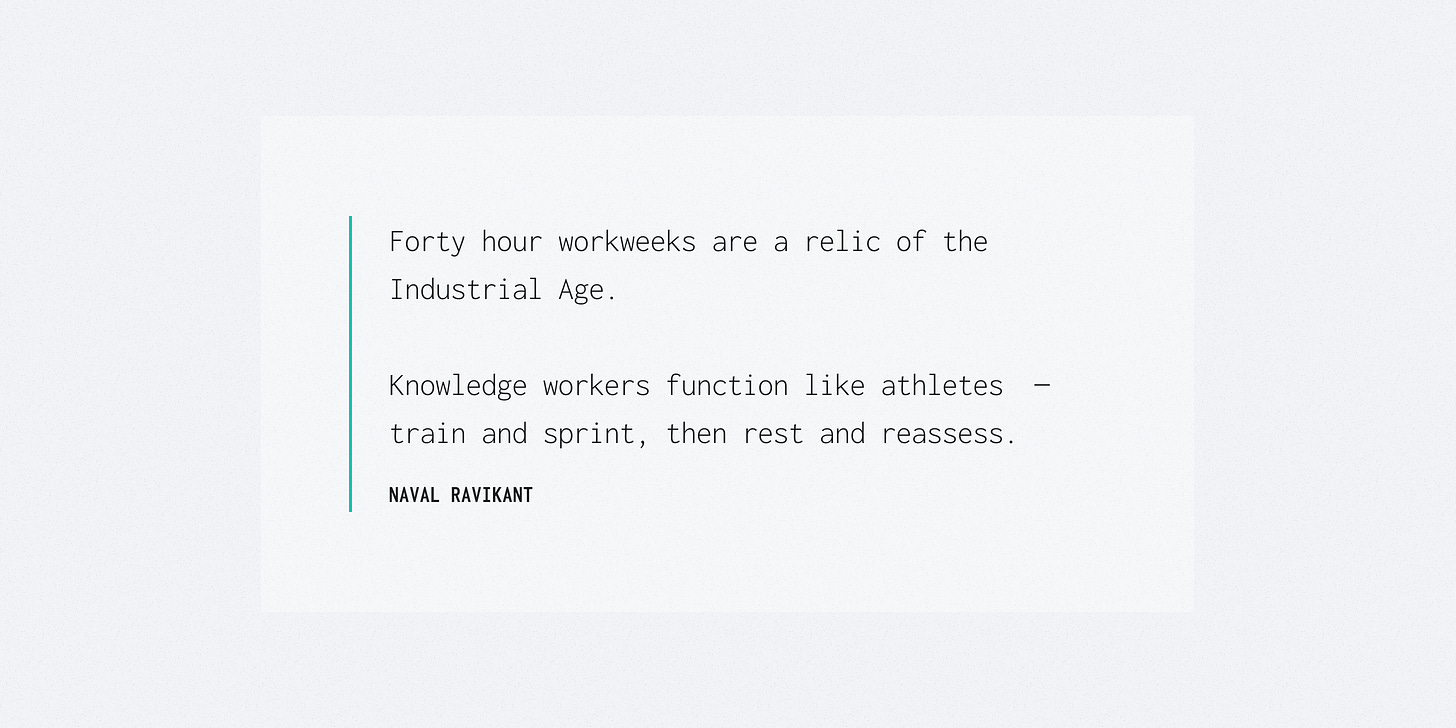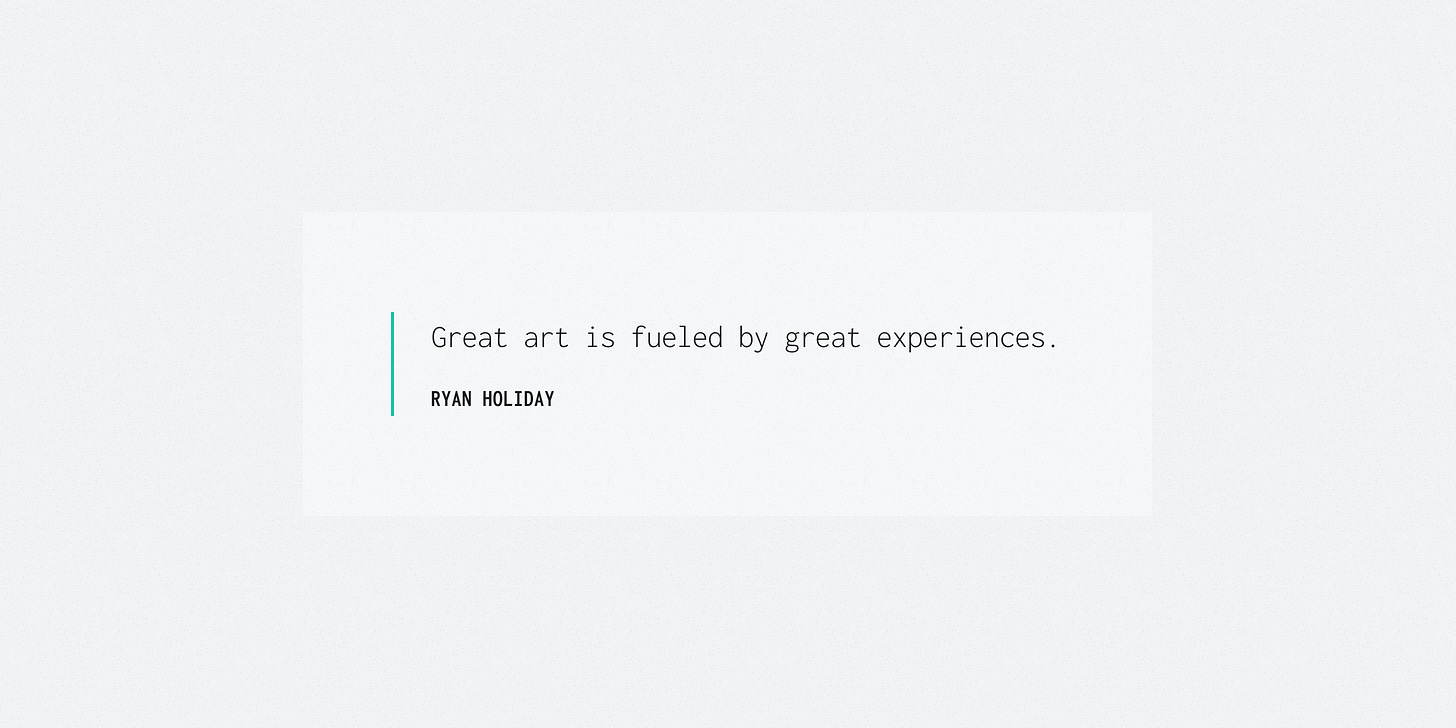How I Find Balance with Creative Work
Keeping the ideas flowing in spite of the 40-hour week and hustle culture grind.
Hello everyone!
Today I want to talk about balancing work as a creative person.
Culturally, we’re caught in the crossfire of the legacy of the industrial, 40-hour work week combined with the always-on, internet, hustle culture.
I feel it grinding on both me and the people I know.
I see more people taking sabbaticals to reset their creative systems simply because the professional world hasn’t adapted to allow a work cadence that’s productive and sustainable for creative people over the long haul.
It’s an insidious slide because the flow of ideas restricts gradually for the creative professional until, all of a sudden, the valve is closed and all that’s left is to force out work that lacks substance.
In terms of the work week, there’s a disconnect between how organizations want to measure creative productivity versus how productive creators actually produce.
And in terms of hustle culture, there’s a disconnect between the push to get ahead by “creating content” versus doing what truly sparks better creative work.

“Train and sprint, then rest and reassess.”
The 40-hour work week was a good idea for the workers it was designed to protect in the industrial age, but it doesn’t make sense for creative, knowledge-based jobs. It presumes a linear relationship between the hours put in and the output that results; that one more hour of “work” will create one more hour of usable output.
But good creative work isn’t so neatly linear. It depends on executing focused bouts of work for brief durations followed by periods of rest and recovery.
In this way, it behaves a lot like training for a sport. Each day there is only so much training your body can accept that will contribute to growth. After that point, additional training gets less effective until it eventually becomes outright harmful.
So what does that look like in the context of a work week?
For me, it looks like aiming to focus for about 3-4 hours per day, then taking time to recover and let ideas collide and percolate.
Some days it’ll be more, others less, but in general, that’s what I need to make progress. Just the equivalent of a focused morning.
Like in training, recovery isn’t wasted time; it’s critical to the process of growth. It doesn’t look much like the traditional idea of “work”, but those moments away allow my internal dialogue to go into overdrive processing all that it needs in order to turn out an insight the next time I sit down to focus.
To non-creative people, that might sound like an excuse not to work but it’s really the opposite. The truth is that if I don’t take that time, I basically won’t be able to work. The odds are I’ll just end up staring blankly into my screen making no progress which is good for precisely no one.
The key to creative progress isn’t that you grind more every day, it’s that you focus the right amount each day so that when paired with your recovery you get consistent growth over time. Don’t worry about how that maps to hours “on the clock”. Worry about the consistency and quality of your results.
So if you’re an individual contributor on your team, shoot to find the balance between training and recovery, between focused work and rest. And if you’re a manager, make sure to lead by example and encourage your team to bake in routine time to recover from their focused work. If you don’t make the space for it, they certainly won’t.
Don’t let the content pipeline kill your creativity
If you spend any time trying to build a creative project online, one of the first things you’ll run into is the push to create more and more “content”.
Especially as a solo creator this need for content can quickly feel like a Sisyphean task. Even with a well-thought-out strategy for how to remix your ideas into many media formats, it’s still a grind.
Sooner or later, the pressure for more content morphs the creative work you set out to make into something created not because you like it, but because you anticipate it will perform. In the process, you exhaust your precious creative energy filling the content pipeline rather than filling your creative spirit, making burn-out just a matter of time.
YouTuber Cam Walker (aka Struthless) has a great piece about this slippery slope from artist to content creator that I’d highly recommend watching (linked above).

I like this quote from Austin Kleon because it’s a great reminder to not overburden myself with too much busy work. It accurately reflects what I know I need in order to do my best creative work. Namely, a lot of “free” time.
Now, usually, this time isn’t literally spent sitting around doing nothing, but rather it’s time that is unscheduled, unstructured, and unencumbered.
It’s time when no one is expecting anything from me.
It’s time when I have the headspace for ideas to form.
And it’s time when I can turn off the ceaseless, noisy stream of the internet.
This is when I’m best able to focus and this is when I feel free to create.
It’s one important antidote I use to slow my creative poisoning by content pipeline.

Live like your creativity depends on it.
So now you might be wondering, “Well, Pat, if I can’t just content-create my way to the top, then what exactly am I supposed to do to get ahead?”
The long and short of it is: go do interesting stuff.
It’s tough to admit, but you won’t have interesting, unique ideas without that input. Instead, you’ll just be regurgitating one person’s idea because you think another person might respond to it.
And while that’s not the end of the world, when it comes to your creativity, you don’t want to just be a mirror, only reflecting others’ experiences and ideas. You want to be a prism, breaking apart experiences into something new and unique for the world.
Now, that doesn’t mean you always have to be on the go, but it does mean that you routinely need new stimuli to be able to form new ideas. You need to cast a wide net and then give yourself the space to make connections that others can’t see.
When you’ve completed that first step of gathering new experiences, the only thing left to do is to sit your butt in the chair and start to create.
You don’t need an extra degree.
You don’t need anyone’s permission.
And you definitely don’t need one more thought framework from a 23-year-old on Twitter.
You just need to start creating and recovering each day, building your skill and body of work along the way. Not hustling content, but just making, day-in and day-out.
It’s as simple and as daunting as that.
See ya next week,
Pat
Similar posts
If you got a little value in this post, consider subscribing, sharing, or following me on Twitter. If you got a lot of value I’d appreciate it if you bought me a coffee 😎☕️.





